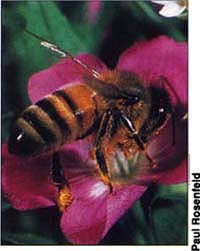All Issues
Research update: Africanized Bees: Ready or not, here they come
Publication Information
California Agriculture 48(2):6-6.
Published March 01, 1994
PDF | Citation | Permissions
Abstract
The bee front has been spreading at a rate of 100 to 300 miles per year.
Full text
As the weather warms and Africanized honey bees in Arizona and Mexico increase their feeding and reproduction rate, swarms will move into areas of less competition, said UC Extension Apiculturist Eric Mussen, who expects them to arrive in California this spring.
The Africanized honey bee (AHB) has already made itself at home in southern Texas and has been detected in Yuma, Arizona, near the California border. In preparation for its arrival, San Diego County Farm Advisors Karen Robb and Vince Lazaneo and 4H Youth Advisor Steve Dasher have developed materials instructing Californians in how to deal with the invasion.
AHBs are extremely defensive, highly reproductive and tend to abandon the hive when disturbed. They are more likely to defend a larger area around their nest and will pursue a target 1/4 mile or more. Although European and Africanized bees carry the same venom and can sting only once, AHBs respond faster and in greater numbers.
Dubbed “killer bees,” they have been blamed for the multiple stinging deaths of 176 people in Mexico from 1988 through October 1993, according to a USDA Agricultural Research Service report. In the United States, one person, an 82-year-old Texas man attacked in July 1993, has died from AHB stings. Most people who have died were unable to flee. Confined animals, such as pets and livestock, are particularly vulnerable.
The invasion of AHBs will affect all Californians — particularly the state's pollination services. European honey bees are used as pollinators for 47 different California nut, fruit, vegetable and forage seed crops valued at $1.8 billion annually. California almonds alone require 800,000 colonies for pollination.
AHB is a hybrid of the European and African honey bees. The two genotypes were cross bred in 1956 by a Brazilian geneticist who aspired to create a more productive bee for use in the tropics. However, a fierce and unmanageable type of bee evolved from this hybrid and swarms escaped to form feral bee populations. The wild bees with African characteristics have proliferated and expanded their range at a rate of 100 to 300 miles per year, according to Lazaneo, and will probably enter California through the Imperial Valley.
The San Diego advisors have published “Bee Alert” pamphlets in English and Spanish, which are available from ANR Publications in Oakland. They provide general precautions, suggestions for beeproofing your home and recommendations in case of an encounter.
“If bees are encountered,” says the pamphlet, “get away quickly. While running away, try to protect face and eyes as much as possible. Take shelter in a car or building. Water or thick brush does not offer enough protection. Do not stand and swat at bees; rapid motions will cause them to sting.”
Working with UC communications specialist Gary Beall, Robb, Lazaneo and Dasher are also developing a slide set and a video for adults and an instructional kit for children.
AHBs look like European honey bees and don't always respond by stinging, according to Mussen. However, beekeepers will notice other behavioral differences in hives containing AHBs. European bees calm down when smoke is blown into their hive, while AHBs will immediately take flight from the combs when a smoked box is opened and run around nervously when the comb is lifted.
To reduce the risk and liability of unmanageable bees, beekeepers may be forced to requeen their colonies more frequently. Within about 6 weeks of the introduction of a new queen, worker bees are replaced by her offspring.
UC Davis entomologist Robert Page has received funding from the California Department of Food and Agriculture and several commodity groups to help prevent derailment of agriculture's pollination services.
Page is studying different bee breeding and mating systems to ensure good queens are selected, propagated and distributed. He recommends maintaining pure European bee stocks because, he said, “I don't feel confident that we can improve Africanized bees. As they are, they cannot be used in California agriculture.”
Page is exploring the use of morphometric measurements and DNA analyses, seeking a better method of identifying honey bees if a certification program is enacted. Studying the genetics of the Africanized bee, he hopes to reveal the source of its defensive behavior.
Establishment of AHB in California is imminent, according to Page. Noting the abundant feral honey bee population, he said. “If it happens here like it has elsewhere, once the Africanization process begins, in three years we'll have total conversion.”
—Editor





